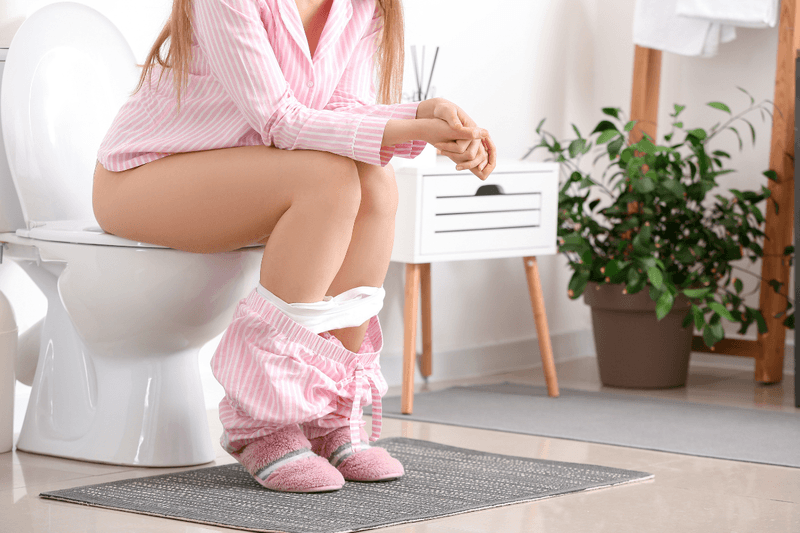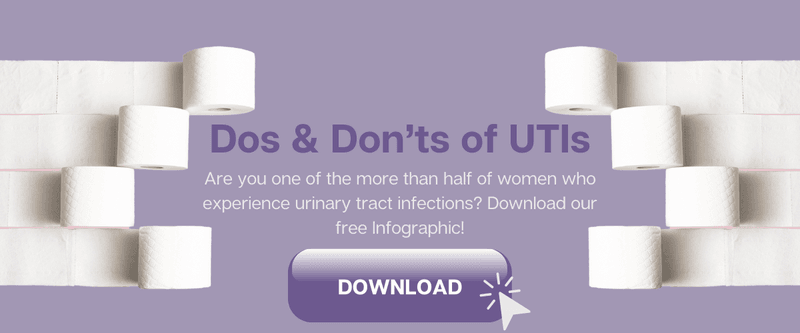Do you find yourself constantly rushing to the bathroom, even when you’ve just emptied your bladder? If this scenario sounds familiar, you may have an overactive bladder.
In this article, we’ll delve into overactive bladder and nighttime urination as we uncover their causes and symptoms and their link to urinary tract infections (UTIs). We’ll also address common questions about these conditions and reveal effective treatments to minimize their impact on your daily life.

Overactive Bladder: Definition and Symptoms
Overactive bladder, also known as OAB, is a medical condition that affects the urinary system and is characterized by these common symptoms:
- Urge incontinence: This refers to the involuntary leakage of urine due to the sudden and intense urge to urinate. It can happen before reaching the toilet, and the leakage can vary from a few drops to a complete loss of bladder control.
- Frequent urination: People with overactive bladder often feel the need to urinate more frequently than normal. This can result in visiting the bathroom eight or more times daily and sometimes even at night (nocturia). The frequent trips to the bathroom can disrupt daily activities and affect sleep patterns.
- Urgency: A hallmark symptom of an overactive bladder is a strong and compelling sensation of needing to urinate immediately. The urgency can be overwhelming and difficult to ignore or postpone, leading to dashes to the bathroom. You can try the AZO Bladder Control with Go-Less Daily Supplement as you wait to get an appointment with your gynecologist.
How Overactive Bladder Affects Nighttime Urination
Nocturia, or nighttime urination, poses a significant challenge for women with overactive bladder. Beyond mere inconvenience, it disrupts their sleep patterns, resulting in fatigue and reduced daily productivity. The urgency to urinate can abruptly wake them from a deep slumber, making it difficult to return to sleep.
This disruption creates a ripple effect on their overall health and well-being, causing heightened daytime fatigue, diminished focus, and even impacting their mood and relationships.
Causes of Overactive Bladder
Understanding what causes an overactive bladder entails considering several key factors, such as the following:
Lifestyle Factors
- Excessive fluid intake: Consuming large amounts of fluids, especially those with diuretic properties like caffeinated beverages or alcohol, can stimulate the bladder and increase its activity, leading to more frequent urination.
- Poor fluid management: On the other hand, not drinking enough fluids can result in concentrated urine. This can irritate the bladder’s lining, intensifying the symptoms of an overactive bladder.
- Obesity: Carrying excess weight can put additional pressure on the bladder, weakening the muscles and affecting its ability to store urine properly.
- Smoking: Smoking can inflame the bladder lining and exacerbate overactive bladder symptoms. The chemicals in tobacco smoke can also increase the risk of bladder cancer, leading to bladder dysfunction.
Underlying Medical Conditions
- UTIs: Infections in the urinary tract, particularly the bladder, can cause irritation and inflammation, leading to overactive bladder symptoms.
- Neurological disorders: Conditions that affect the nerves controlling bladder function, such as multiple sclerosis, Parkinson’s disease, or spinal cord injuries, can disrupt the normal signaling between the bladder and the brain.
- Bladder abnormalities: Structural abnormalities in the bladder, such as bladder stones, tumors, or prolapse (when the bladder drops into the vaginal area), can cause overactive bladder symptoms.
Age-Related Changes
- Hormonal changes: During menopause, the decrease in estrogen levels can lead to a decline in the elasticity and strength of the pelvic floor muscles and bladder tissues.
- Weakening of bladder muscles: Over time, the bladder muscles can weaken, reducing their ability to stretch and store urine effectively.
- Decreased bladder capacity: As we age, the bladder’s capacity to hold urine may decrease, leading to more frequent urination and overactive bladder symptoms.
Overactive Bladder and Urinary Tract Infections
Does an Overactive Bladder Cause UTIs?
While overactive bladder and UTIs are distinct conditions, they can sometimes coexist or share similar symptoms. Overactive bladder does not directly cause UTIs, but certain factors associated with overactive bladder can increase the risk of developing UTIs.
For example:
- Incomplete emptying: Individuals with overactive bladder struggle to empty their bladder during urination. When urine remains in the bladder, it creates an environment that promotes bacterial growth and increases the risk of UTIs.
- Frequent urination: Overactive bladder often leads to more frequent trips to the bathroom, which can increase the likelihood of exposure to bacteria and potential UTI-causing pathogens.
- Weakened immune response: Overactive bladder symptoms and chronic bladder irritation can compromise the immune system’s ability to fight infections, making individuals more susceptible to UTIs.
It’s important to note that while an overactive bladder can heighten the risk of UTIs, it does not directly cause them.
Recognizing UTI Symptoms
UTIs are bacterial infections that can affect any part of the urinary system, including the bladder, urethra, and kidneys.
Women are more prone to UTIs because of their anatomy. The shorter tube (urethra) that carries urine from the bladder allows bacteria a quicker path to the bladder, increasing the likelihood of infection. The urethra’s proximity to the anus also puts women at a higher risk of bacteria spreading from the digestive system to the urinary tract.
UTIs often come with noticeable symptoms. Here are some common signs to watch out for:
- Frequent and urgent urination: As mentioned earlier, UTIs can have the same symptoms as an overactive bladder.
- Burning sensation: You might experience a burning or stinging sensation when you urinate. This discomfort can be quite bothersome.
- Cloudy or bloody urine: UTIs can cause changes in the appearance of urine, such as cloudiness or the presence of blood.
- Lower abdominal pain or discomfort: Some people with UTIs may feel pressure or mild pain in the lower abdomen or pelvic region.
- Fatigue and general malaise: UTIs can make you feel unwell, causing fatigue, mild fever, and a sense of overall malaise.
Treatment and Prevention of UTIs
While mild UTIs can resolve on their own, it’s not advisable to rely on treating them at home without seeking medical attention.
Treating UTIs involves a course of antibiotics prescribed by a healthcare professional. For women, reaching out to your obgyn is the best option. It’s essential to complete the full course of antibiotics to ensure complete eradication of the infection.
In addition to treatment, there are preventive measures that can help reduce the occurrence of UTIs:
- Stay hydrated: Drinking an adequate amount of water helps flush out bacteria from the urinary tract. Aim for about 6–8 glasses of water per day unless otherwise advised by a healthcare professional.
- Practice good hygiene: Wiping from front to back after urinating helps prevent the spread of bacteria from the anus to the urethra.
- Empty the bladder regularly: Avoid holding urine for extended periods, and fully empty the bladder during each trip to the bathroom.
- Urinate before and after intercourse: Emptying the bladder before and after sexual activity can help flush out any bacteria that may have entered the urethra.
- Consider cranberry products: Some research suggests that cranberry products, such as cranberry juice or supplements, may help prevent UTIs by interfering with the adherence of bacteria to the urinary tract walls. But it’s important to consult with a healthcare professional before incorporating cranberry products into your diet.
UTI Supplements
- Garden of Life Dr. Formulated Probiotics Urinary Tract+
- Love Wellness UTI Don’t Think So
- OLLY Happy Hoo-Ha Capsules
- D-Mannose Urinary Tract Health

Treatment of Overactive Bladder
Simple lifestyle changes can make a big difference when managing an overactive bladder. Here are some behavioral modifications that can help:
- Fluid management: Adjusting your fluid intake can help control bladder urges. It’s important to stay hydrated, but try to spread out your fluid intake throughout the day and avoid excessive intake close to bedtime.
- Dietary modifications: Certain foods and beverages can irritate the bladder and worsen symptoms. Consider reducing or avoiding caffeine, alcohol, spicy foods, and artificial sweeteners, as they can trigger bladder overactivity.
- Timed voiding: Establishing a regular schedule for emptying your bladder can help retrain it and reduce the frequency of sudden urges. Gradually increase the time between voiding to encourage better bladder control.
Medications for Overactive Bladder
In some cases, medications may be prescribed to control the symptoms of overactive bladder. These medications work differently to relax the bladder or reduce its sensitivity. Commonly prescribed medications include:
- Anticholinergics: Anticholinergic medications work by blocking the effects of acetylcholine in the bladder. Doing so, they help relax the bladder muscles and reduce the frequency and urgency of urination. This can give people with overactive bladder more control over their bladder function.
- Beta-3 adrenergic agonists: These medications target a specific receptor called the beta-3 adrenergic receptor in our bodies. It leads to decreased muscle contractions and reduces the urgency to urinate.
Bladder Training and Pelvic Floor Exercises
These exercises are non-invasive techniques that can strengthen the muscles involved in bladder control. Here’s how you can incorporate them into your routine:
- Bladder training: Gradually increase the time between bathroom visits to stretch the bladder and improve its capacity. Over time, this can help you regain control and reduce urgency.
- Pelvic floor exercises: Also known as Kegel exercises, these exercises involve contracting and relaxing the muscles that support the bladder. Regular practice can strengthen these muscles and improve bladder control. You can consult a gynecologist to ensure you are performing them correctly.
Surgical Interventions
In cases where other treatment methods haven’t provided sufficient relief, surgical interventions can be considered. These options are typically reserved for severe cases or when conservative measures are unsuccessful. Surgical interventions can include:
- Sacral nerve stimulation: This procedure involves implanting a device that stimulates the sacral nerves that control bladder function. The stimulation helps regulate nerve signals and reduces bladder overactivity.
- Bladder augmentation: In rare cases, bladder augmentation may be recommended. This surgery involves enlarging the bladder using tissue from other body parts, which increases its capacity and reduces symptoms.
Relief is Within Reach at The Woman’s Clinic
To say that living with an overactive bladder is challenging would be an understatement. Not only are the symptoms distressing, but they also carry the risk of progressing into other conditions, such as UTIs.
But with the right strategies and support, overcoming an overactive bladder is possible. That’s why it is crucial to address the symptoms and seek medical advice from your healthcare provider. These steps will result in a proper diagnosis and access to effective treatment options tailored to your needs.
Request an appointment with our physicians to receive the care you deserve today, and download our infographic about the Do’s and Don’ts of UTIs so you can stay proactive in managing your overall health!


